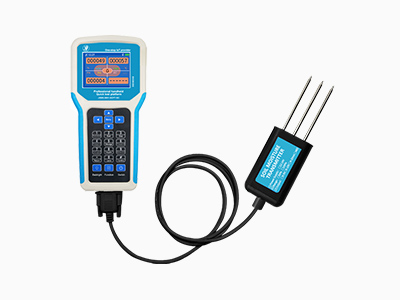Introduction Soil health and nutrient management are critical factors in agricultural productivity and sustainability. The ability to accurately monitor and manage soil conditions is essential for optimizing crop yields, conserving resources, and minimizing environmental impact. In recent years, advancements in sensor technology have revolutionized the way farmers and agricultural professionals approach soil health and nutrient management. Soil sensors provide real-time data on soil moisture, temperature, nutrient levels, and other key parameters, enabling precise and targeted interventions to maximize agricultural productivity while minimizing environmental impact.

Understanding
Soil Sensors Soil sensors are electronic devices designed to measure various physical and chemical properties of soil. These properties include moisture content, temperature, pH, electrical conductivity, and nutrient levels. By providing real-time data on these parameters, soil sensors empower farmers and agricultural professionals to make informed decisions about irrigation, fertilization, and other practices that influence soil health and crop productivity.
Types of Soil Sensors There are several types of soil sensors available, each designed to measure specific soil properties. Some of the most common types of soil sensors include:
Moisture Sensors:
These sensors measure the water content in the soil, providing valuable information about soil moisture levels and helping farmers optimize irrigation practices.
Temperature Sensors:
Temperature sensors monitor soil temperature, which is crucial for understanding the impact of temperature on plant growth, microbial activity, and nutrient availability.
Nutrient Sensors:
Nutrient sensors measure the levels of essential nutrients such as nitrogen, phosphorus, and potassium in the soil, helping farmers make informed decisions about fertilization and nutrient management.
pH Sensors:
pH sensors measure the acidity or alkalinity of the soil, providing insights into soil chemistry and nutrient availability.
Electrical Conductivity Sensors:
These sensors measure the soil’s ability to conduct electricity, which is indicative of soil salinity and nutrient levels.
Benefits of Soil Sensors The integration of soil sensors into agricultural practices offers numerous benefits for farmers, agronomists, and the environment. Some of the key benefits of soil sensors include:
Precision Agriculture:
Soil sensors enable precision agriculture by providing real-time data that allows farmers to tailor their irrigation, fertilization, and other practices to the specific needs of their crops and soil conditions.
Resource Conservation:
By providing accurate information about soil moisture and nutrient levels, soil sensors help farmers optimize resource use, reducing water and fertilizer consumption while maximizing crop yields.
Environmental Sustainability:
Improved soil health and nutrient management, facilitated by soil sensors, contribute to environmental sustainability by minimizing nutrient runoff, soil erosion, and the leaching of agrochemicals into water bodies.
Cost Savings:
By optimizing inputs such as water and fertilizers, soil sensors help farmers reduce production costs while maintaining or increasing crop yields.
Data-Driven Decision Making:
Soil sensors provide valuable data that empowers farmers and agricultural professionals to make informed decisions about soil health and nutrient management, leading to more sustainable and productive agricultural practices.
Challenges and Considerations While soil sensors offer significant advantages, their adoption and effective use present certain challenges and considerations. Some of the key challenges and considerations related to soil sensors include:
Cost:
The initial investment in soil sensor technology can be a barrier for some farmers, especially small-scale producers. However, as technology advances and adoption rates increase, the cost of soil sensors is expected to decrease over time.
Data Interpretation:
The abundance of data generated by soil sensors can be overwhelming, requiring farmers and agronomists to develop the skills and knowledge necessary to interpret and act upon the information effectively.
Calibration and Maintenance:
oil sensors require regular calibration and maintenance to ensure accurate and reliable measurements. Proper calibration and maintenance procedures are essential for maximizing the effectiveness of soil sensor technology.

Integration with Farm Management Systems:
Integrating soil sensor data with farm management systems and decision support tools can present technical challenges, requiring compatible software and hardware solutions.
Education and Training:
Effective use of soil sensors requires education and training for farmers and agricultural professionals to fully understand the capabilities and limitations of the technology.
Future Directions As technology continues to advance, the future of soil sensors holds great promise for further improving soil health and nutrient management in agriculture. Some potential future directions for soil sensor technology include:
Advanced Sensor Networks:
The development of advanced sensor networks that can provide comprehensive, real-time data on soil conditions across large agricultural landscapes.
Integration with Precision Farming Technologies: Integration of soil sensors with other precision farming technologies, such as GPS-guided machinery and variable rate application systems, to further optimize agricultural practices.
Artificial Intelligence and Machine Learning: Leveraging artificial intelligence and machine learning algorithms to analyze and interpret soil sensor data, providing actionable insights for farmers and agronomists.
Miniaturization and Cost Reduction: Continued miniaturization and cost reduction of soil sensor technology, making it more accessible to a wider range of farmers and agricultural professionals.
Conclusion Soil sensors represent a powerful tool for improving soil health and nutrient management in agriculture. By providing real-time data on soil moisture, temperature, nutrient levels, and other key parameters, soil sensors enable precision agriculture, resource conservation, and environmental sustainability. While challenges such as cost, data interpretation, and integration exist, the potential benefits of soil sensors for agriculture are substantial. As technology continues to advance, the future of soil sensors holds great promise for further enhancing agricultural productivity and sustainability.
In conclusion, harnessing the power of soil sensors is crucial for optimizing soil health and nutrient management, ultimately contributing to more sustainable and productive agricultural practices.
